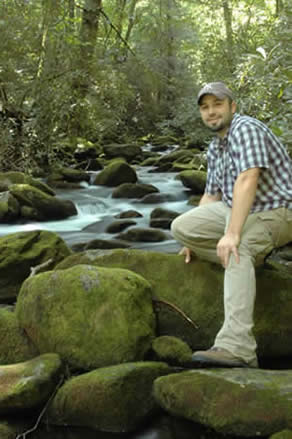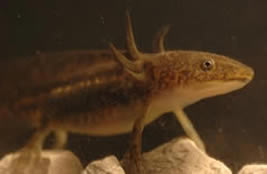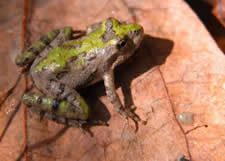Dr. Cy L. Mott

Contact Information
Phone: 229-333-7851
Office: 1212 Bailey Science Center
Education and Experience
B.S., Biology; Minor, Chemistry, East Stroudsburg University
M.S., Biology, Shippensburg University
Ph.D., Zoology, Southern Illinois University Carbondale
Postdoctoral Research Associate, Watershed Studies Institute, Murray State University
Teaching
- BIOL 1107: Principles of Biology
Visit Dr. Mott's Personal Web Page
Research
My research encompasses issues in behavioral ecology, macroecology, biogeography, and conservation biology, with a primary focus on amphibian taxa from vernal ponds and other aquatic habitats. Using field, mesocosm, and laboratory experimental designs, I seek to answer questions of why species, populations, and individuals occupy the space that they do, how such spatial distributions may change through time due to species interactions, and how ecological and evolutionary processes serve to maintain the size and shape of species geographic ranges.
- Temporal patterns in intraguild interactions

Intraguild predation is a complex trophic phenomenon wherein potential competitors can also prey upon one another, leading to simultaneous competitive, predator-prey, and cannibalistic interactions. For larval amphibian communities, these risks are compounded by the temporary nature of their rapidly drying pond habitats. Identifying factors underlying changes in the strength and/or direction of intraguild interactions is therefore critical in determining which species will persist. Previous and ongoing undergraduate research relating to this topic includes: a) assessments of dietary partitioning among related and unrelated cohorts of larval salamanders to examine mechanisms of kin discrimination and its effects on coexistence; and b) determining the foraging consequences of non-lethal injuries among salamander larvae incurred during intraguild interactions.
- Amphibian macroecology and biogeography
Species’ geographic ranges are considered the ultimate expression of their ecological niches, and range size is often utilized to assess extinction risk, yet few studies have sought to examine the underlying factors associated with “where ectothermic taxa occur”. I am in the process of identifying the specific morphological and ecological variables most closely associated with geographic range size among all North American amphibian species,  which will both inform management decisions for imperiled species and facilitate future investigations of range-limiting phenomena. Furthermore, species are expected to exhibit an “abundant center distribution”, wherein populations are most dense and/or numerous at the center of the range and become more sparse towards range peripheries. These generally assumed (but rarely tested) patterns, however, have not been confirmed for amphibians, one of Earth’s most imperiled vertebrate groups, nor have the consequences of potentially reduced densities of peripheral populations been characterized. Together with Dr. Emily Croteau of VSU, I am analyzing data from the North American Amphibian Monitoring Program (NAAMP) to determine if pond-breeding amphibians adhere to the abundant center distribution, while assessing the relationship between distance from range edges and genetic variation among core and peripheral populations of the northern cricket frog, Acris crepitans.
which will both inform management decisions for imperiled species and facilitate future investigations of range-limiting phenomena. Furthermore, species are expected to exhibit an “abundant center distribution”, wherein populations are most dense and/or numerous at the center of the range and become more sparse towards range peripheries. These generally assumed (but rarely tested) patterns, however, have not been confirmed for amphibians, one of Earth’s most imperiled vertebrate groups, nor have the consequences of potentially reduced densities of peripheral populations been characterized. Together with Dr. Emily Croteau of VSU, I am analyzing data from the North American Amphibian Monitoring Program (NAAMP) to determine if pond-breeding amphibians adhere to the abundant center distribution, while assessing the relationship between distance from range edges and genetic variation among core and peripheral populations of the northern cricket frog, Acris crepitans.
- Within-den beaver behavior
Although my research program is largely amphibian-centered, I am also engaged in ongoing collaborative research with Dr. Clay Nielsen of Southern Illinois University Carbondale to examine patterns of beaver behavior as they occur within lodges and bank dens. Despite the relative ubiquity of beavers in North America, very little is known about behavior patterns “behind closed doors” within their complex, multi-generational familial units, and the results of our efforts should provide basic natural history data and inform management activities for one of our most recognizable ecosystem engineers. Popular coverage of this research by the BBC can be seen here:
(http://news.bbc.co.uk/earth/hi/earth_news/newsid_9283000/9283367.stm)
Publications:
Mott, C. L. and T. J. Maret. 2011. Species-specific patterns of predation and non-lethal aggression among three syntopic species of larval ambystomatid salamanders.Copeia 2011:9-17.
Mott, C. L., C. K. Bloomquist, and C. K. Nielsen. 2011. Seasonal, diel, and ontogenetic patterns of within-den behavior in American beavers. Mammalian Biology76:436-444.
Mott, C. L. 2010. Environmental constraints to the geographic expansion of plant and animal populations. Nature Education Knowledge 1:72.
Mott, C. L. and D. W. Sparling. 2010. Seasonal trends in aggression among sympatric larval salamanders: the roles of habitat-mediation and behavioral conservatism. Behaviour 147:1327-1353.
Mott, C. L., S. E. Albert*, M. A. Steffen*, and J. M. Uzzardo*. 2010. Assessment of digital image analyses for use in wildlife research. Wildlife Biology 16:93-100.
Mott, C. L. and D. W. Sparling. 2009. Ontogenetic patterns of agonistic behavior in a guild of larval ambystomatid salamanders. Journal of Herpetology 43:532-540.
Department of Biology
-
Room 2035, 2nd Floor
Bailey Science Building -
Mailing Address
1500 N. Patterson St.
Valdosta, GA 31698 - VSU - Department of Biology
- Phone: 229.333.5759
- Department of Biology Fax
- Fax: 229.245.6585
Monday - Friday
8:00 AM - 5:00 PMSaturday - Sunday
CLOSED